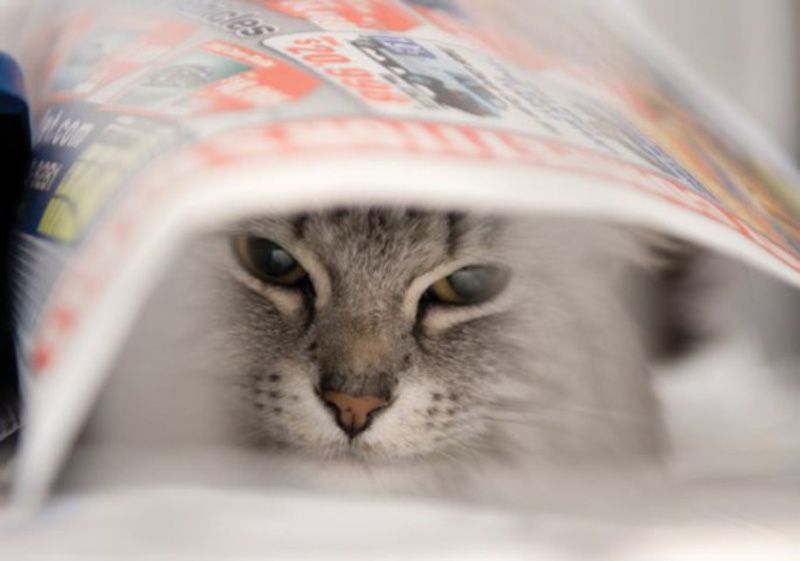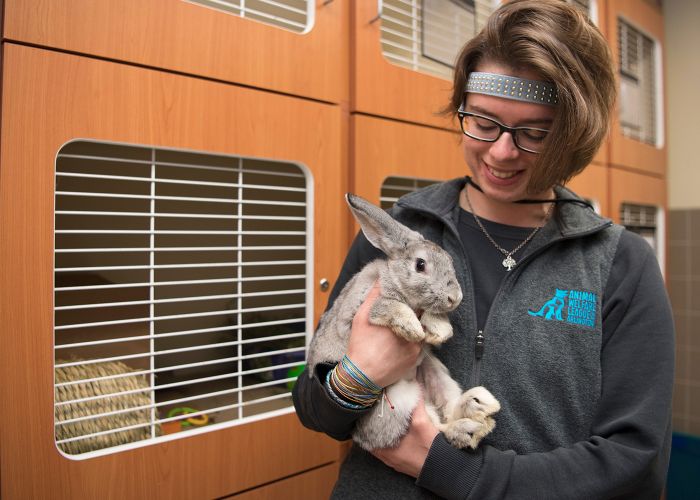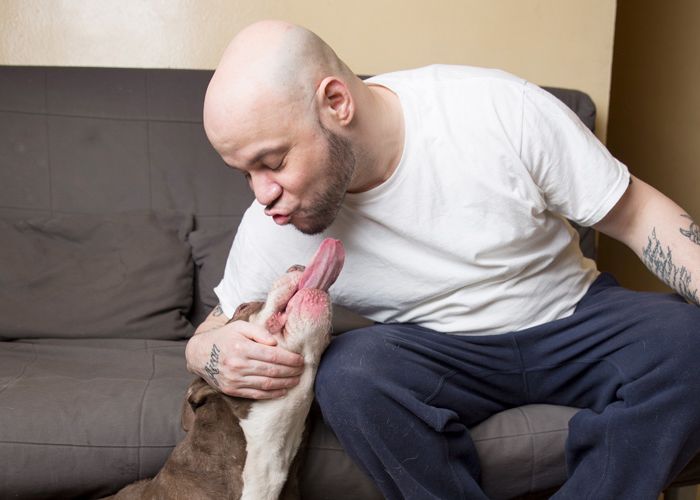Spot-cleaning cat cages
These days, beating germs doesn’t always mean a bleach bath

If you’ve ever had a pleasant dinner party interrupted by a cat who wanders in, plunks himself down, and begins performing the most intimate cleaning in full view of the table—feet lifted well beyond his head in a kind of obscene yoga, licking with the kind of focused attention usually reserved for advanced calculus—you know: The ways in which kitties clean can make us humans uncomfortable.
Turns out, the feeling is mutual.
But whereas our discomfort usually lasts only as long as our awkward diversion of our dinner guests’ attention (“Hey, how about those brussels sprouts, huh?”), kitties stressed by traditional cleaning methods within animal shelters may experience the effects for much longer. And those effects may damage their health.
For years, the standard approach to cleaning a cat cage involved removing the cat, placing her in a nearby cage or carrier, and conducting a cleaning, scrubbing, bleaching, and otherwise dirt-obliterating routine within the cage she occupied. By the time the process was done, germs in the cleaned cage were (at least in theory) kaput.
But sometimes the kitty herself carried some germs on her paws or muzzle, and left them in the new spot, spreading them along the line. Sometimes the traditional cleaning didn’t really reach every germ—it’s incredibly easy for a microscopic particle to find a hiding place in the nook or cranny of a cage door or the lip of a food bowl. Sometimes harsh chemicals weren’t rinsed adequately, causing cats to develop raw paws and muzzles from bleach.
More fundamentally, this process ignored the fact that kitties thrive on routine and familiarity. They like to know where they are. They like to have places to hide. And while a human nose might detect a little animal smell and find it offensive, to a kitty it can say, “That’s me. I’ve been here before. This is my house, my litter box, my mousie, and I feel great about it!”
The end of the old school
Over the years, the strategy for cleaning cat cages has shifted—and experts believe that’s a good thing. “I think it’s because of more shelter vets looking at actual data and URI [upper respiratory infections] being so prevalent in shelters,” says Carolyn Machowski, manager of the Shelter Services program at Humane World for Animals (HSUS). “And I think they really directed some research into seeing how come URI was so prevalent. It’s the development of seeing what stress, moving fomites on people’s clothes … what kind of effect that had on the cat’s immune system.”
For years, Machowski notes, it’s been ingrained in shelter personnel that the biggest weapon against disease is disinfection. “And so it’s really hard to turn that attitude around. The attitude that with disinfectants, more is better. But the scents linger, and they can be irritants. I don’t think we were looking at what that overload of chemical smell was doing to the cats.”
For cats, stress can be a killer—and being moved out of one cage and into another, or being taken out and then returned to a cage that no longer smells the same, has proved stressful to kitties. It’s not that hard to understand: Imagine if you came back to your apartment one day to find all your furniture had been moved, your posters rearranged, and the whole place smelled like disinfectant … and you had no idea how or why. And it happened the next day. And the next. Freak-out time!
Happily, this bleach-bomb approach to cleaning isn’t necessary—or rather, it’s not necessary to do it every day, to every cat cage. In fact, it shouldn’t be.
The new way
Spot-cleaning is the method that should replace it. Rather than a full-on, deep-scrub, floor-to-ceiling blitz, spot-cleaning is more of an easygoing tidy-up. It boils down to the following simple steps:
- Allow each cat to remain in the cage. Provide a paper bag or cardboard box for her to hide in if she’s particularly nervous or timid.
- If you’re working with a notorious escape artist and you must remove him from the cage to work, put him in a cardboard carrier during your quick cleanup. This cardboard carrier can be used throughout his stay in the shelter, and can go home with him—it shouldn’t be used for any other cats.
- Remove the litter box and replace the litter (or, while wearing disposable gloves, simply pick out the big clumps and discard them).
- Dump the bowl and provide fresh food and water. Wash bowls only if they are “gross.”
- Shake out towels and blankets into the trash, and then put them back where they were. Only replace bedding if it’s wet or visibly dirty. Clean cat toys can also stay in place.
- Wipe off any obvious stains or organic matter using a clean, wet rag or paper towel, but no disinfectant. (Keep in mind, if using a rag, that you’ll need a new one for any cage requiring wiping.)
- Only move the cat and do a full cleaning if the cage is really trashed and messy.
- Refrain from petting and cuddling cats as you work—this is a time to clean, and your goal is to minimize the amount of germs/virus the cat will shed onto you as you work, so that you won’t spread it to the next cages.
This probably sounds too good to be true. It does to many shelter staff—and it is a little more complicated, as you’ll see below. But these are the basic steps involved.
When she first tried to institute the practice at her former shelter, says Inga Fricke, director of sheltering initiatives at The HSUS, her staff understandably fought the change. Some said they’d never do it. They said it would end up killing every cat in the shelter.
“So we actually compromised,” says Fricke. “I said, ‘We’re going to do spotcleaning six days a week, and one day a week you get to do full cleaning.’ And within three months I had the same people coming to me and saying, ‘This is stupid—why are we full cleaning one day a week?’ They saw disease transmission going down, they went from every single cat in the shelter is sneezing, every single cat in this room is sick, to the sick room being empty.”
Caveat cleaner
So you knew this was coming. There’s got to be a catch.
And there is. In fact, there are three. But none of them should terrify you. If your shelter is doing a good job of segregating its population—keeping sick cats and healthy cats separated, maintaining isolation wards, protecting juveniles—the first caveat is nothing to sweat over.
You can’t just go row by row. The whole principle behind spot-cleaning, behind the idea that total disinfection is not necessary and may even cause harm, is that a cat’s own germs/saliva/mucus/secretions will not make that cat sick—but that it can make other cats sick. So when you’re making your cleaning rounds, you cannot simply go from one cat cage to the next. You have to clean the cages in an order than makes sense according to principles of disease resistance and immunity, starting with the animals whose immune systems are most vulnerable (for example, kittens), and ending with those animals who are most likely to be shedding virus (adult, healthy cats and especially pregnant cats).
“If you’re looking at a room where you have [a group consisting of] a pregnant, adult healthy cat; an adult healthy cat; a cat with a broken leg; an adult healthy cat, and a kitten who just came in … the kitten in that room is going to be potentially the most susceptible to illness,” says Fricke.
The idea, she says, is to lessen the viral load. “If you just start from one side of the room and go around, then you’re just adding fomites, adding all of the disease onto whatever you come in contact with, and by the time you get to that kitten, the viral load, the dose that they’re getting, is going to be a little bit from everybody in that room.”
That’s just what you don’t want.
Full disinfection should still be performed on any community areas. Again, remember the principle: Fluffy’s germs won’t make her sick, but they will make Tiger sick.
It’s helpful to think of each cat cage as that cat’s safe little “pod,” and everything outside of it as “the danger zone.” Every space in the shelter that gets contacted by multiple cats must continue to get the full disinfection treatment every day. That goes for visiting rooms, cages in your clinic, exam tables, and so forth. And any cage that is being emptied—when a cat goes to a new home, for example—must be thoroughly disinfected as well.
Community cat rooms are the exception to this “clean everything outside the cage” rule. Shelters that have community rooms should treat those shared areas the same way they treat other living spaces for cats, and spot-clean there rather than doing the full disinfection needed for areas where “strangers” regularly come and go.
Time saved should not be wasted. You’ll find that this process eliminates much of the time you’ve previously spent scrubbing cat cages. Don’t waste it—use it to ensure the disinfection of the shared spaces (as mentioned above) and to invest in enrichment programs for your cats. Play soft music, supply catnip toys and cardboard scratchers, have volunteers engage them in interactive (but non-germ spreading) play with laser pointers and wands. Provide them with hiding places and perches within their cages.
If you’re trying to change outcomes for cats in your shelter, spot-cleaning—done right—is a good step to take.
“It’s very counterintuitive to tell staff that you keep a population healthier by not cleaning as much. That just doesn’t seem to make sense,” says Fricke. “But that’s why it’s so important that you explain not just how you do it but why. Why it matters that cats are so connected with their territory, why it matters that just the least bit of change can cause stress, why it matters that, when you have a cat sitting inside a 2-by-2 metal box, that those smells are going to be trapped in there and be so much more exacerbated to them. Once you explain to people the why, it makes it a little easier to stomach and they go, ‘Well, maybe.’”
Let us know if there are issues your organization is struggling with—we may address them in a future article! Send questions to asm@humanesociety.org.






